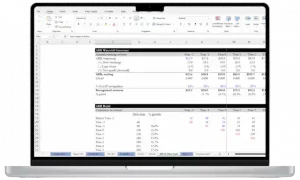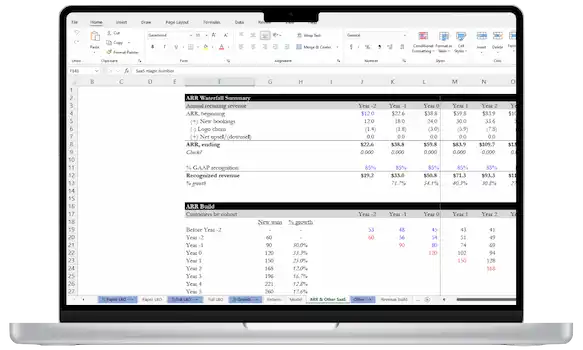What is ARR?
Annual recurring revenue, or ARR, is a critical measure of performance for SaaS companies. Since subscriptions are the lifeblood of SaaS companies, measuring revenue as a recurring event only makes sense.
While total revenue may be slightly higher if it includes one-time revenue sources, a company’s recurring revenue is typically the most important metric that Saas companies track.
In this article, we’ll dive into how to calculate ARR, why it’s important, and tangible examples.

How do I calculate ARR?
One way of calculating the annual recurring revenue is as follows:
Total annual recurring revenue = Monthly recurring revenue x 12
As you can see, if your subscription model is monthly rather than annual, you can calculate ARR by multiplying the MRR by 12.
However, to better understand the components of recurring revenue, let’s look at another definition:
Previous period ARR + New ARR – Churned ARR + Net expansion ARR = Current period ending ARR
The annual subscription revenue is based on the base price for each subscription. To keep things simple, assume that you only have one subscription price of $100/month.
If you have 2,500 customers, your annual subscription revenue would be $100 x 2,500 x 12 = $3,000,000.
If you offer a discount for annual billing such as $1,000 for a full years’ subscription, that will slightly lower your subscription revenue, while simultaneously decreasing churn.
If a customer pays an extra $20/month for an optional subscription extra, such as expedited customer service, this would count as new ARR. However, revenue from one-time services, such as onboarding costs, would not count as add-on recurring revenue.
Net expansion ARR is the recurring revenue that existing customers add or subtract to their bill during the course of the year.
Churned ARR is recurring revenue that used to be recurring revenue but has been lost since the customer ended their relationship with the company during the year.
Decreasing churn directly impacts your annual recurring revenue, as each customer retained is another month or year’s worth of value to your ARR.
Why is ARR important?
Annual recurring revenue is one of the most important measures of revenue for SaaS companies as their business models are heavily based on subscriptions.
ARR in SaaS is a measure of how strong the company is, how they measure up against competitors, and ultimately how large their revenue base is.
In investing interviews, its very common to be asked interview questions related to ARR. For instance, one of the most common questions is “Walk me from through the components of an ARR waterfall.”
If you are asked to do this in an interview, you can simply layout the definition of ARR outlined above and explain what each component is and how it impacts ending ARR.
What is the difference between ARR and MRR?
ARR is measured on an annual basis, while MRR is measured on a monthly basis.
Both are useful in different ways. ARR is typically used in reference to B2B SaaS offerings, whereas MRR is more commonly seen in B2C SaaS offerings.
This difference is mostly attributable to the fact that B2B SaaS offerings tend to have lower churn. Therefore, it makes sense to look at them from an annual basis.
Meanwhile, B2C offerings tend to have such high monthly churn it makes more sense to use MRR in certain contexts.

- 33 lessons
- 8+ video hours
- Excels & templates
What are the alternatives to ARR?
If a business only has monthly subscription packages with no option for annual discounts, MRR may be a more useful metric than ARR.
Total contract value, or TCV, is a very similar metric to ARR and can be used in many of the same situations. The difference between contract value and annual recurring revenue is that contracts aren’t always one year long.
For instance, if a business has a contract for 6 months, or two years, the total contract value will not translate directly to the annual value of the contract.
The other difference between TCV and ARR is that TCV includes any non-recurring revenue included in that customer’s contract. Each metric has a specific place and a way that it can serve the business and its investors.
Finally, it can be worthwhile to look at NRR, or non-recurring revenue, alongside ARR. As the name suggests, this is one-time revenue that is unlikely to continue.
While this is not an alternative to ARR, it is a nice adjunct to ARR and a way to get a more complete picture of a company’s financial performance.
ARR and GAAP Revenue
Generally Accepted Accounting Principles, or GAAP, require revenue to be reported in the month that it is earned.
Since ARR looks at revenue in one lump sum (at a single point in time), it is not a GAAP-approved method for measuring or tracking revenue.
For GAAP purposes, SaaS ARR is simply not used. Rather, it is used for non-GAAP analysis, such as for a budget estimation or financial modeling projection by investors.
That said, since SaaS companies don’t necessarily have a defined end date for the services they provide to their customers (e.g. open-ended contracts), companies can put constraints on their ARR calculation methods to ensure that ARR and GAAP revenue are more closely aligned.
Even though ARR isn’t a GAAP metric, it is still among the gold standard of metrics used by investors to assess software revenue.
This is because it gives a sense of the “go forward” revenue (expected over the next year and beyond), rather than a backward looking view of what’s been earned already (GAAP revenue).
A real-world ARR example
Earlier, we looked at a very simple ARR example with one monthly subscription package. A more realistic example would include a few different subscription levels, add-ons, one-time fees, and a churn rate.
Suppose our SaaS company has two different subscription levels:
A basic package at $15/month, or $150/year when paid annually
- 20,000 customers subscribe to the basic package. 5,000 of them have paid annually.
- The basic package has a one-time $10 onboarding fee for each new customer, and subscription add-on options for $5/month. 10,000 customers pay for the add-ons.
An enterprise package at $45/month, or $450/year when paid annually
- 1,000 customers subscribe to the enterprise package, and 900 of them have paid annually.
- The enterprise package has a one-time onboarding fee of $30, and a subscription add-on for $10/month. 400 customers pay for add-ons.
To calculate ARR with this information, we can start with the number of customers who pay for their packages annually and monthly.
For the basic package:
- 5,000 annual customers x $150 = $750,000
- 15,000 monthly customers x $15 x 12 = $2,700,000
- $750,000 + $2,700,000 = $3,450,000 from basic package
- Add to this the extra 10,000 x $5 = $50,000 from subscription add-ons for a total ARR of $3,500,000
For the enterprise package:
- 100 monthly customers x $45 = $4,500
- 900 annual customers x $450 = $405,000
- $405,000 + $4,500 = $450,000 ARR from enterprise package
- Add to this the extra 400 x $10 = $4,000 from subscription add-ons for a total ARR of $454,000
Added together, the total ARR from both subscription packages comes to $3,954,000.
Total revenue overall would include the one-time onboarding fees from each client:
- $10 x 20,000 customers = $200,000 from the basic package
- $30 x 1,000 customers = $30,000 from the enterprise package
- This extra $230,000 in revenue is not included in ARR, but brings the total revenue for the year to $4,184,000
FAQ: What is the difference between ARR and ACV?
Annual recurring revenue and average contract value both measure the conceptual value of subscriptions and contracts. However, they do so and are used in different ways.
ARR measures total recurring revenue, whereas ACV is usually used to measure the worth of individual contracts, or the average worth of any given contract.
ARR is used to comparatively measure the overall growth of the company year-over-year, and ACV is used to measure how effectively each customer contributes more value to the company.
For example, suppose an SaaS company has an ARR of $1.0 million, and an ACV of $10,000. However, the next year, they have an ARR of $1.5 million, but an ACV of only $9,500.
Comparing the growth of these two reveals that the company is bringing in new customers, but they are failing to make each customer pay more in revenue to the business through additional subscriptions or more valuable add-ons.
FAQ: What is cumulative ARR?
Cumulative ARR is total recurring revenue over multiple years (rather than the next twelve months).
It is usually graphed on a curve alongside customer acquisition costs or CAC payback period to show how long each customer’s acquisition costs will measure against their total lifetime value.
ARR is a useful metric for SaaS companies because it provides a performance benchmark for internal and external interested parties. CEOs, CFOs, and investors alike find ARR interesting.
It can stand alone as a performance metric, and it can also provide growth insights when combined with other metrics such as ACV or CAC.
Next steps
To go deeper, check out other articles in my SaaS metrics series or check out my complete online course on SaaS metrics and financial modeling to achieve mastery.


 SaaS & Growth Metrics
SaaS & Growth Metrics Break Into Growth Equity
Break Into Growth Equity
